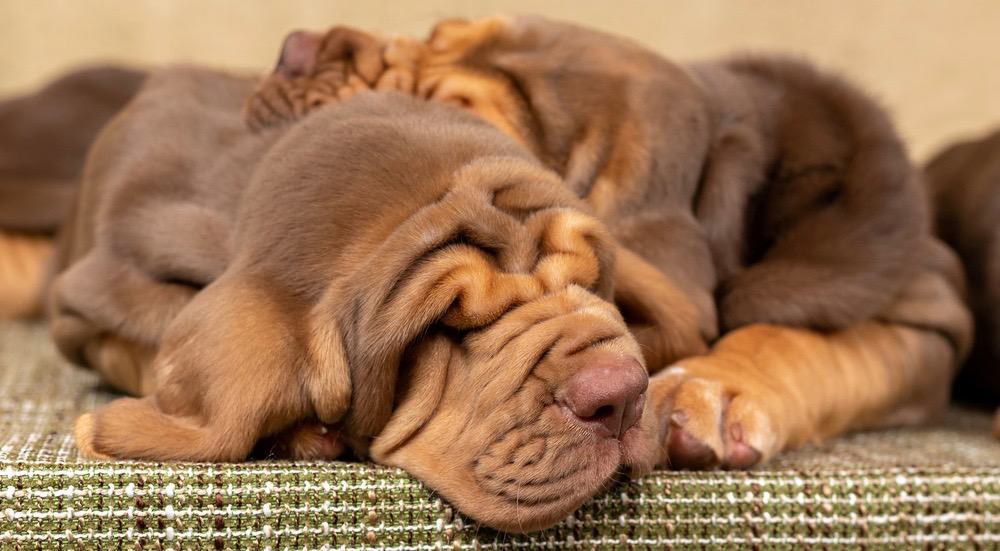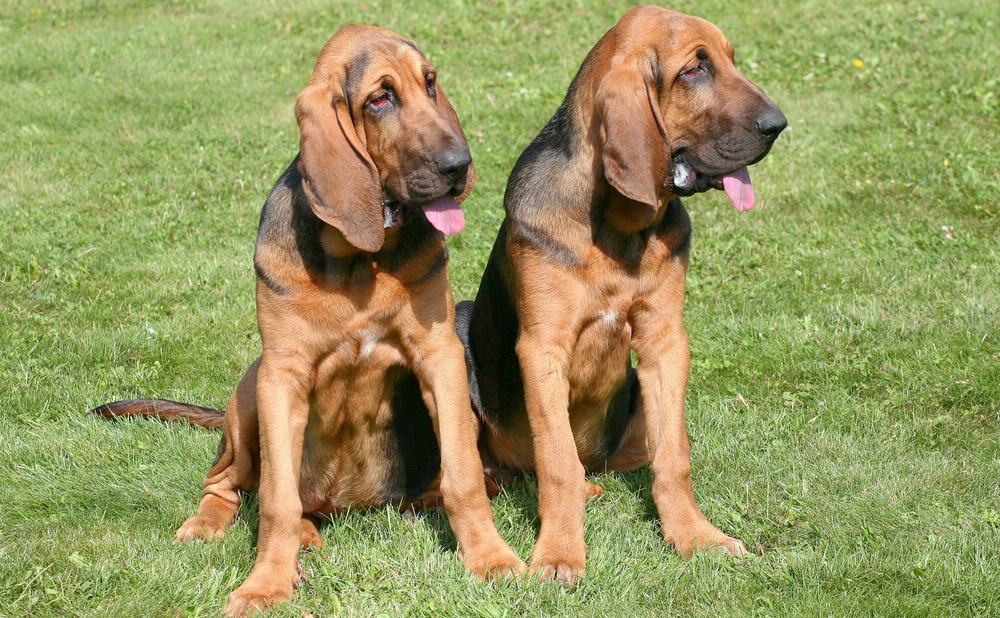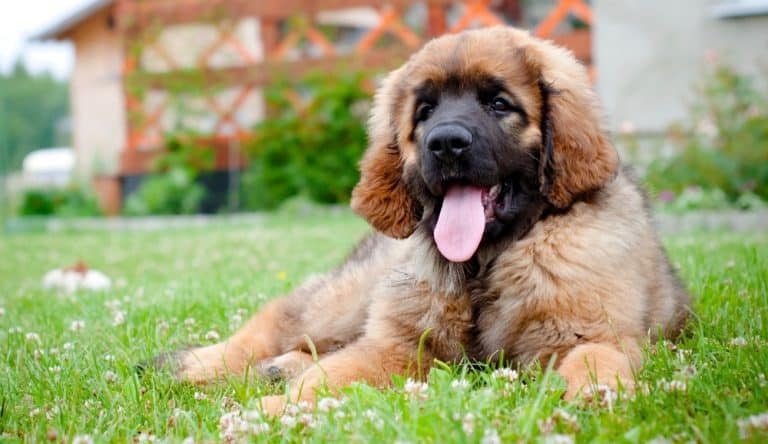Bloodhound Weight Chart – Size & Growth Chart
Knowing what to expect throughout the growth of your Bloodhound puppy will help you to monitor their weight and ensure that they are healthy.
A Bloodhound weight chart shows what your puppy should weigh at a certain age.
A Bloodhound puppy is fully grown at the age of 18 and 24 months. They weigh between 80 and 130 pounds and stand at a height of around 23 and 27 inches as adults. Typically, females are lighter and smaller than male Bloodhounds.
This article will provide you with more information about the Bloodhound growth chart, what happens during their growth stages, how much they cost, and many more.
When Is A Bloodhound Fully Grown?

Since the Bloodhound is a large breed, they take more time to fully grow. Typically, Bloodhounds reach their adult weight and height between the ages of 18 and 24 months.
This is when they are fully grown and don’t expect to see any physical changes. They are mentally mature at the age of 2 years.
Bloodhounds grow rapidly and they add between 3 to 5 pounds every week. They experience the most growth between 4 to 8 months old.
During this period, a Bloodhound puppy needs extra care because their rib cage, body, head, leg bones, spine, and other parts are expanding.
Bloodhound Weight Chart
The weight of your Bloodhound can be affected by their genetics, diet, health, and physical activity.
Your puppy’s weight should be ideal for their weight category to ensure that they are not at risk of weight-related health conditions such as dysplasia and heart disease.
At 4 months, a Bloodhound puppy should weigh between 35 and 45 pounds. At 8 months, they should weigh between 75 and 95 pounds.
Feeding your puppy healthy and balanced foods as well as giving them enough exercise will ensure that they maintain a healthy weight according to the Bloodhound weight chart.
Bloodhound Puppy Weight Chart
| Age | Weight (kg) | Weight (lbs) |
|---|---|---|
| 3 Months | 14.4 - 17.1 kg | 31.8 - 37.6 lbs |
| 4 Months | 19.2 - 22.4 kg | 42.3 - 49.4 lbs |
| 5 Months | 23.4 - 27.1 kg | 51.6 - 59.7 lbs |
| 6 Months | 26.9 - 31.5 kg | 59.3 - 69.5 lbs |
| 7 Months | 31.9 - 35.2 kg | 70.3 - 77.6 lbs |
| 8 Months | 34.1 - 38.8 kg | 75.2 - 85.5 lbs |
| 9 Months | 36.5 - 41.3 kg | 80.5 - 91.0 lbs |
| 10 Months | 37.5 - 43.5 kg | 82.7 - 95.9 lbs |
| 11 Months | 38.0 - 44.8 kg | 83.8 - 98.8 lbs |
| 12 Months | 38.5 - 46.3 kg | 84.9 - 102 lbs |
Bloodhound Growth Chart – What to Expect

Birth – 2 Weeks
This is the neonatal stage, and your puppy depends entirely on his mother for nutrition and warmth. During week 1, your puppy cannot see or hear and cannot manage his body temperature.
During week 2, your puppy’s eyes start opening and they start noticing their environment. They will also have a 5% to 10% increase in body mass.
3 Weeks – 12 Weeks
This is the socialization stage, and your puppy can now be introduced to their environment. They start wagging their tail and can now start playing because their legs are getting stronger.
At 6 weeks they can be weaned, and you can introduce puppy food. They can leave their breeder at the age of 8 weeks.
They also need to be vaccinated during this period.
4 Months – 9 Months
At four months, you can start training your puppy at home and they can learn new things. Short walks can be introduced in their exercise routine.
They reach adolescence at 6 months, and they start showing their fear, disobedience, and dominance, which is the right time to train them on obedience.

At nine months, you can transition them to adult food. Ensure that you do the process slowly to avoid stomach issues.
10 Months – 18 Months
During this stage, your Bloodhound starts showing sexual behaviors if they were not neutered or spayed.
Being a large breed, a Bloodhound needs proper training, and this is the time to take them to an advanced obedience class. Otherwise, they may want to be the alpha of the house.
Adult
From 18 months onwards, your Bloodhound is considered an adult and they will have reached their adult weight and height.
If there are any changes in their weight, it means that you are overfeeding them. Therefore, you should help them lose weight to keep them healthy.
How Big Do Bloodhounds Get?
There are two ways you can predict the size of your puppy when they are fully grown: parents and paws. The size of your puppy’s parents will give you an exact indication of the adult size of your puppy.
Speak with your breeder to give the rough estimates of your puppy’s adult size basing on their parent’s information.
The paws are another indicator of your puppy’s size as an adult. If the paws are unusually small, chances are high that your puppy will be small and if the paws are unusually large, your puppy will be a large dog as an adult.

On average, expect your male Bloodhound puppy to weigh between 90-130 pounds and stand at 25-27 inches tall as an adult. On the other hand, an adult female Bloodhound stands at about 23-25 inches tall and weighs around 80-100 pounds.
Will Neutering/Spaying My Bloodhound Affect His Growth?
Spaying(females) and neutering(males) are the removals of reproductive organs surgically. Talk to your vet to know the exact time to neuter or spay your Bloodhound.
However, it is recommended that you neuter or spay your puppy between the ages of four and nine months.
Spaying or neutering can be beneficial to your puppy as it prevents breeding for males and pregnancy for females. They also reduce the risk of cancer related to the reproductive organs and can reduce aggressive behavior.
If neutering or spaying is done too early, your puppy’s growth can be affected because the growth plates have not yet closed. Therefore, you must wait until your puppy has reached puberty to spay or neuter them.
Bloodhound Size Chart
You can use a measuring tape to measure the height of your Bloodhound puppy at home. Let your Bloodhound stand against a frame or wall.

To find your puppy’s weight, you first need to find their withers, which are the highest point of the shoulder blades. Next, measure from the ground to the withers, and this is your puppy’s height.
On average, the height of a female Bloodhound is between 23 and 25 inches while that of their male counterpart is between 25 and 27 inches.
Basset Hound vs Bloodhound Size
A Basset Hound is categorized as a medium dog while a Bloodhound is a large dog.
On average, a male Basset Hound weighs between 50 to 64 pounds and stands at around 11 to 15 inches while a male Bloodhound weighs between 90 to 130 pounds and stands at about 25 to 27 inches.
A female Basset Hound weighs between 45 to 60 pounds with a height of around 11 to 14 inches while a female Bloodhound weighs between 80 to 100 pounds with a height of around 23 to 25 inches.
Factors That Affect Bloodhound Growth
The following factors can affect the growth rate of your Bloodhound puppy:
Genetics & Gender
Since genetics is passed down from the parents to the puppies, a Bloodhound’s size is hugely affected by the size of their parents.
If the parents are big, your puppy will grow to be a big as an adult and if the parents are small, your puppy is likely to have a small frame as an adult.
Generally, adult male Bloodhounds are heavier and larger than female Bloodhounds.
Nutrition
The nutrition of your Bloodhound puppy should include high-quality food whether homemade or commercially manufactured.
You should seek your vet’s recommendation and approval before starting your puppy on any diet.

Ensure that the diet is appropriate for your puppy’s age to avoid overfeeding and unnecessary weight gain.
Treats can be used during training but in small amounts as too much can lead to obesity. Ensure that your puppy has access to fresh and clean water throughout the day.
Physical Activity & Health
Bloodhounds are active dogs and need daily exercise to stay fit and healthy. Bloodhounds enjoy long walks and can go hiking with you.
However, avoid strenuous exercises that can affect your puppy’s joints. Physical activity will help your puppy stay in good shape and avoid health issues.
Genetically, Bloodhounds are predisposed to certain health conditions, therefore, a regular visit to the vet is advised for early diagnosis and treatment.
What If My Bloodhound Is Not the Right Weight?
If your Bloodhound is overweight, he can be affected by serious health conditions such as dysplasia, heart disease, and articulation problems.
Underweight Bloodhounds can be sick as well. If you notice that your puppy’s weight is not ideal for their age, take them to the vet for a medical check-up, because there could be illnesses causing the weight changes.
Your vet can also help you come up with a plan to help your Bloodhound lose weight at home. The following are the steps to follow:
Change diet – reduce the amount of food you are giving your puppy and feed them high-quality food with all the nutrients, vitamins, and minerals.
Exercise – in addition to diet, exercising your puppy will help them lose weight. Exercises such as ball games, slow walking, fast walking, and swimming are great for weight loss.
Treats – swap the commercial treats for fruits and vegetables. This will remove unnecessary calories that may be increasing your puppy’s weight.
How Much Does It Cost To Own A Bloodhound?
If you are looking to own a Bloodhound, then you need to consider whether you can afford one or not. On average, a Bloodhound puppy costs around $700, but the price can be as high as $5,000 or low as $500.
The initial cost can vary because of the type of Bloodhound, the breeder, the location, and the demand in your location. If you want a cost-effective option, then choose to adopt a Bloodhound as it can cost you between $200 and $400.
Other costs that you will incur in the first year of owning a Bloodhound include grooming items, beddings, food bowls, and collars. This can range between $245 and $925.
Bloodhound Genetics And Common Health Problems
Generally, Bloodhounds are healthy, but they are at risk of certain health conditions. This does not mean that your puppy will get these diseases, but as a Bloodhound owner, it is essential to be aware of them. They include:
Hip and Elbow Dysplasia – this hereditary condition affects the hip and elbow joints which leads to lameness and pain on the legs of your puppy. These conditions can be treated by surgery, anti-inflammatory medication, or weight management.
Hypothyroidism – this is because of thyroid hormone deficiency and can lead to obesity, infertility, lack of energy, and mental dullness. This condition can be managed through a daily pill for thyroid replacement.
Ectropion – this is sagging or rolling out of the eyelids which makes the eye prone to infection and nutrition. it can be corrected through surgery if it is severe.
Epilepsy – this condition causes seizures and can be managed through medication.
Bloat – this is the presence of gas in your puppy’s stomach. It happens when your puppy drinks lots of water, eats rapidly, feeds on one large meal, or exercises rapidly.
Fold Dermatitis
Final Words
Being a large dog, a Bloodhound tends to show independence and stubbornness. However, they are patient, gentle with a loving temperament.
If you are looking to get one, ensure that you are committed to providing them with adequate exercise, a well-balanced diet, and obedience training.
You should also be consistent and patient with them, and they will be a wonderful companion.







